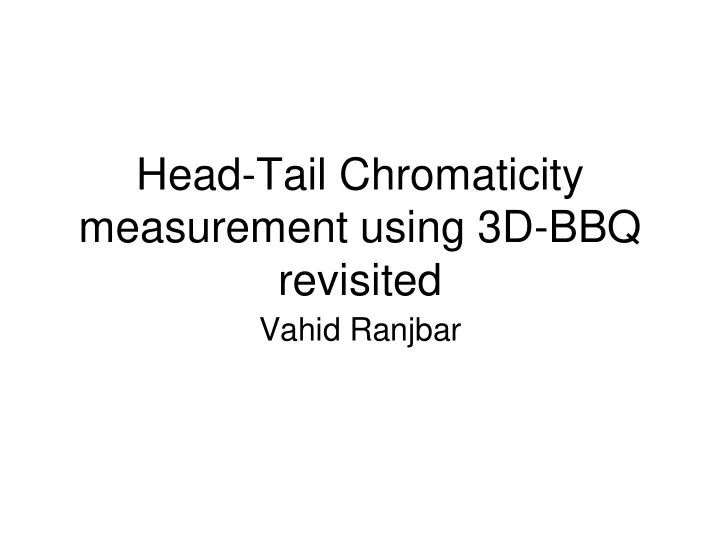

Head-Tail Chromaticity measurement using 3D-BBQ revisited Vahid Ranjbar
Motivation • We are interested in investigating non-destructive methods to measure chromaticity in RHIC • In particular the head-tail phase difference approach using BBQ to detect head and tail phases. • About 6 years back, C.Y.Tan, R. Jones and others at CERN considered the possibility of using the BBQ to sample the head and the tail to extract chromaticity via the head-tail phase shift. • We considered both an isolated kick method and a continuous kick approach to piggy back on the pll tune measurements. • We were unsure at the time if a continuous kick approach would yield usable phase information. However subsequent theoretical and experimental work using an AC dipoles and sampling via a scope showed that there was a clear phase shift which persists while the beam is continuously driven. • However both the kicked and continuous excitation approach showed that there were problems with phase jitter related to the peak selection of the BBQ which made this an unreliable. • I have a new idea which may resolve the issue of phase jitter by summing a carefully placed narrow pulse at the location in the bunch which we wish to sample.
Longitudinal Beam Dynamics D P/P w s H T t Longitudinal ‘phase - space’ Graph 2 q s ( s ) r sin( 2 q s / C ) s C z ( s ) r cos( 2 q s / C ) s
Chromaticity Measurement Using Head-Tail Phase Shift In the presence of non-zero chromaticity the betatron frequency is perturbed by: w w w ( ) 0 0 the equation of motion per particle becomes: w t 0 A exp[ i ( 2 Qn ( 1 cos( 2 q n )) sin( 2 q n ))] s s q s Which when integrated over a guassian distribution gives[1]: w 2 2 2 w t 2 0 sin ( 2 q s n ) t t 2 2 0 ( , , ) sin 2 ( 1 cos( 2 )) X n e Qn q n s
The result of this simple model predicts a beam envelope which recoheres every half synchrotron period. Chromaticity = 3 0.996 1 Y n 10 mm 0 0.999 1 0 100 200 300 400 500 600 700 800 900 1000 1 10 3 0 n turn number And a phase which recoheres every full synchrotron period reaching a maximum phase difference every half synchrotron period. Thus from the phase difference between two locations in a bunch the chromaticity can be calculated using: D w D t (cos( 2 nq ) 1 ) o s
Set-up flipped polarity In the original experiment at the Tevatron and then latter at the SPS we attached the BBQ to the stripline or BPM with one of the diodes flipped to sample the negative peak. The output of the BBQ was then sampled by a fast digital oscilloscope at 25MHz
1.5 1.037 1 n ) Dt A ( m M .6 f s 0.5 n ) Dt A 0 ( m M .6 .5 0 f s n 0.5 ) Dt t A 0 ( m M .6 .5 f s 1 1.036 1.5 0 5 10 15 20 25 30 35 40 45 50 0 m 49 The BBQ peak detects. Because of the over-lap in the doublet positive and negative peak detector should effectively sample different parts of the bunch. However the peak location in the bunch may experience some jitter which should be correlated with: closed orbit offset, kick amplitude and rms bunch length. X t t X 0 A 0 t t 0.5 t t 1 27
Some results for the kicked method in the Tevatron 3.5 3.5 2 2 D 1 k D 1 k 0 0 1.5 1.5 5 10 4 1 10 5 1.5 10 5 2 10 5 2.5 10 5 3 10 5 0 5 10 4 1 10 5 1.5 10 5 2 10 5 2.5 10 5 3 10 5 0 0 k 3 10 5 0 k 3 10 5 BBQ Chromaticity = 5.04 units Traditional Head-Tail = 5.2 Peak chromaticity 4.4 units occurs ~ 60 turns later than It should. Traditional Head-Tail = 4.29 3.5 2 D 1 k 0 1.5 5 10 4 1 10 5 1.5 10 5 2 10 5 2.5 10 5 3 10 5 0 3 10 5 0 k BBQ Chromaticity = 3.66 units Traditional Head-Tail 5.86
At the SPS the results of continuous excitation also showed phase shift. However it was not consistent.
Careful studies at the Tevatron using an AC dipole and scope showed definitely that there is a phase shift correlated with Chromaticity.
The experiment showed that there was a quadratic term not accounted for in the theory. Latter work has more recently indicated that this is probably due to mixing of 2 nd order Chromaticity and Impedance. In any case it is probably linear enough for a feedback system to work and in worst case can be accounted for empirically. However the issue of phase jitter remains.
Proposed Solution • To control the sampled position of the BBQ in the bunch, we propose summing a controlled square pulse of <= 0.5 nsecs to force the BBQ to select only the local peak and thus betatron oscillations at the location of the pulse. In this case we can also now separate the pulse from the reflected pulse by appropriate summing and delays. Using the positive pulse for head sampling and the negative for tail: 2 0 2 0 20 40 60 80 100 120 Delta Signal W ave Form pulse Sum of Delt a and w ave form
Possibility of resolving full bunch structure • By Splitting the difference signal multiple times and incrementing the location of the summed pulse one could sample the bunch slice oscillations across the whole bunch.
Recommend
More recommend